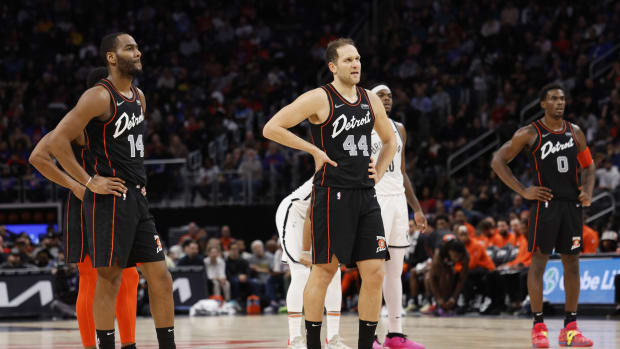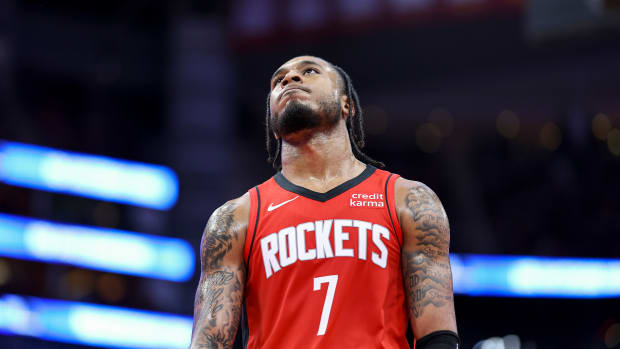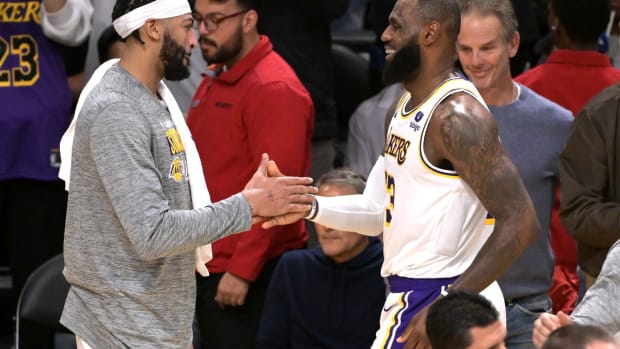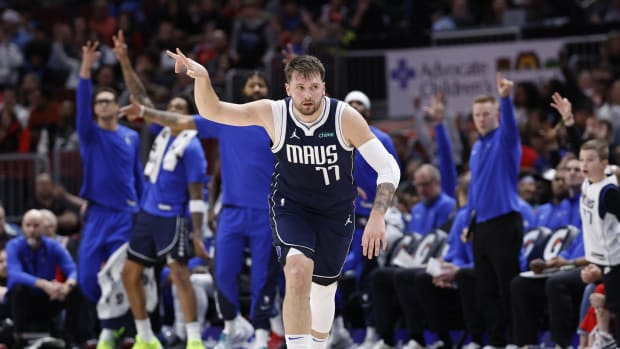Five NBA Teams' Win Totals That Are the Best Bets on the Board
There’s no better way for frothing NBA diehards and degenerates to pass the brief August lull than to dissect the projected win totals for the upcoming 2018–19 season.
Here are Westgate’s updated over/under lines for all 30 NBA teams (current as of Aug. 6).
Atlanta: 23.5 | Brooklyn: 32.5 | Boston: 57.5 | Charlotte: 35.5
Chicago: 27.5 | Cleveland: 30.5 | Dallas: 34.5 | Denver: 47.5
Detroit: 37.5 | Golden State: 62.5 | Houston: 54.5 | Indiana: 47.5
L.A. Clippers: 35.5 | L.A. Lakers: 48.5 | Memphis: 34.5 | Miami: 41.5
Milwaukee: 46.5 | Minnesota: 44.5 | New Orleans: 45.5 | New York: 29.5
Oklahoma City: 50.5 | Orlando: 31.5 | Philadelphia: 54.5 | Phoenix: 29.5
Portland: 41.5 | Sacramento: 25.5 | San Antonio: 43.5 | Toronto: 54.5
Utah: 48.5 | Washington: 44
Let’s dig into five of this year’s best bets. (Disclaimer: For entertainment purposes only.)
Los Angeles Lakers: Under 48.5
The Lakers are set to be one of the most hyped teams in recent memory: LeBron James’s jerseys are flying off the shelves, his workout photos are going viral daily and his new supporting cast is filled with misfit toys and yet-to-blossom prospects. ESPN.com’s Real Plus-Minus projections view the Lakers as this year’s No. 1 outlier: RPM projects L.A. to win 41.2 games, putting it a league-high 7.3 wins away from its Vegas win total. In other words, betting the under is as simple as choosing to run counter to a hype train that is already roaring and could still gain additional momentum.
Advocates for the over will point out that James has won 50+ games for 11 straight seasons (if one adjusts for the 2011–12 lockout-shortened season). Along the way, he’s regularly carried mish-mashed rosters comfortably above 48.5 wins. That includes last season, when the Cavaliers won 50 despite the departure of Kyrie Irving and major injuries to Kevin Love, Tristan Thompson, Isaiah Thomas and others.
NBA Over/Under Bets: Blazers Skepticism, Celtics Confidence and More
Expecting that level of success to continue in the deeper and more loaded Western Conference is unreasonable. Over the last four seasons, James’s teams won 67% of their games against Eastern Conference opponents and 59% against Western Conference opponents. That disparity matters because teams play 52 games within their conference and 30 against the opposite conference. For a more accurate picture of what James is up against in the West, let’s crudely estimate how his last four Cavaliers teams would have fared if they had maintained their winning percentages against each conference while playing 52 games against the West and only 30 against the East.
2018 Cavaliers | Actual wins: 50 | Wins if playing a West schedule: 46
2017 Cavaliers | Actual wins: 51 | Wins if playing a West schedule: 48
2016 Cavaliers | Actual wins: 57 | Wins if playing a West schedule: 58
2015 Cavaliers | Actual wins: 53 | Wins if playing a West schedule: 51
Note that in three of the four years, Cleveland’s projected win total dropped. And in the last two years, the Cavaliers would have gone under the Lakers’ current 48.5 line.
There are additional reasons for Lakers skepticism. The 2018 Cavaliers needed perfect health from James, who played all 82 games, to reach 50 wins. If James misses any amount of time next season, L.A.’s shot at the over instantly dwindles. What’s more, the Lakers will be adopting a Cavaliers-like approach, relying on an excellent offense led by three elite distributors—James, Rajon Rondo and Lonzo Ball—to compensate for a lacking defense. That approach was easier to implement in the East, which was home to just three of the league’s top 10 offenses (including Cleveland) last season. James will likely find it more difficult to prevail in freewheeling shootouts against the West’s superior attacks.
L.A.’s many frontcourt departures have gotten lost in the talk of James’s much-ballyhooed arrival, as well as the curious signings of Rondo, Lance Stephenson, JaVale McGee and Michael Beasley. Brook Lopez left for Milwaukee, Julius Randle signed with New Orleans, and Larry Nance Jr. was traded to Cleveland at last year’s deadline, leaving a shallow frontline rotation that will require James to play heavy minutes at the four and possibly the five.
Upshifting James’s position is an excellent gambit during a playoff series as it creates favorable matchups and allows additional perimeter weapons to get on the court. However, asking him to regularly handle interior defense duties over the course of a regular season is a major compromise given his waning play-to-play effort level on that end. Plus, playing James at the five doesn’t necessarily help L.A. get to shooter-heavy lineups because Ball, Brandon Ingram, Rondo and Stephenson are all mediocre perimeter threats.
The biggest risk in betting the under comes with a very real hypothetical scenario: the Lakers find themselves in a massive playoff bubble competing against six or seven teams for the final four playoff spots. In that scenario, James’s pride could lead him to max out his effort in March and April, knowing that he doesn’t have the luxury of pacing himself for a deep postseason run.
Even that scenario requires numerous assumptions: excellent health from James, good continuity from a brand-new roster, unexpected defensive contributions from a weak-on-paper frontline and demonstrable progress from the likes of Ball, Ingram and Kyle Kuzma. That formula has enough potential breaking points to make one feel comfortable betting the under.
Golden State Warriors: Over 62.5
Here’s an insane stat: The Warriors are 244–45 (.844) during the Steve Kerr era when Stephen Curry is on the court. Translated, that’s a 69-win pace over 82 games. During the past four seasons, Golden State has changed its starting center numerous times, dealt with Kerr’s long-term health absences, incorporated Kevin Durant and repeatedly retooled its bench. Ridiculous.
Prediction: Kevin Durant Will Stay with the Warriors, But Draymond Green Will Go
Zooming out to weigh that sustained track record of excellence is a more convincing sample than simply looking at the 2018 Warriors, who will be remembered as the most-talented and least-motivated 58-win team in NBA history. Indeed, there are two competing narratives about last year’s Warriors. One: they knew they could beat everyone, they got bored, they screwed around and then they took care of business in the playoffs. Two: they lost Curry to a major injury for the first time since 2012 and struggled to replace his playmaking, leadership and night-to-night brilliance.
While there are no doubt elements of truth to the first explanation, the second had a bigger impact on the standings. Despite complacency, postseason hangovers and everything else, Golden State still went 41–10 with Curry in the lineup in 2017–18. If he doesn’t go down with a knee injury in March, the Warriors would have cruised to their fourth straight 60-win season.
Even with a fully healthy Curry, however, the Warriors would likely have fallen short of their 2017–18 preseason win total, which was set at 67.5 wins. If this year’s line was set at that high threshold, betting the under would make sense again. After all, Golden State has no real motivation to go all out in the regular season after beating Houston on the road in Game 7 of the Western Conference finals, and DeMarcus Cousins may not be ready until after Christmas.
But dropping the line from 67.5 wins last year to 62.5 wins this year feels like an overcorrection. Curry remains an MVP candidate, he’s still just 30 and no defense has figured out how to contain him, much less stop him. His partnership with Kevin Durant has produced two titles and survived some rocky moments in the 2018 playoffs, and their combined forces guarantee the Warriors an offense that will be No. 1 or No. 2 next season. If Curry returns to the good health he’s enjoyed in five of the past six seasons, Golden State has the top-end talent to be a 65-win team, even if Draymond Green, Andre Iguodala and Shaun Livingston all show some regression.
Also keep in mind: Curry wasn’t the only Warrior to face health issues last year. Curry (31), Durant (14), Klay Thompson (9) and Draymond Green (12) combined to miss 66 games. Even if Kerr continues to make liberal use of strategic rest for his stars, it’s hard to imagine the core four miss that much time again in 2018–19. Long story short: It’s absolutely possible for the Warriors to suffer from serious complacency issues again and still manage to win 63 or more games.
Utah Jazz: Over 48.5
The Warriors are the only contender with a clearer identity and fewer questions than the Jazz. While Utah’s offseason spending was a bit generous across the board, GM Dennis Lindsey ensured that the top nine players from his playoff rotation will return. The Jazz know exactly who they are: elite on defense, solid on offense, excellent at home and balanced with depth at all five positions. They don’t need to worry about incorporating major new pieces (LeBron James, Kawhi Leonard, Gordon Hayward, Dennis Schroder, Carmelo Anthony) or coping with significant losses (Trevor Ariza, Rajon Rondo, Ersan Ilyasova, Marco Belinelli).
Last season, the Jazz won 48 games but finished with the league’s No. 5 point differential, which put them above the Celtics, Blazers and Cavaliers, all of whom won more than 48.5 games. Rudy Gobert’s knee injury was the biggest factor in Utah’s depressed win-loss record. With Gobert, the Jazz went 37–19, putting them on a 54-win pace. Without the 2018 Defensive Player of the Year, the Jazz went 11–15. Go back to the 2016–17 season, in which Gobert played 81 games and the Jazz won 51, putting them comfortably over this year’s line.
Utah’s causes for optimism extend beyond better health for Gobert. While Donovan Mitchell is a budding All-Star candidate and an obvious pick to make a leap forward in year two, it’s important to note that Joe Ingles is the only member of Utah’s rotation who is over 30. In other words, coach Quin Snyder should expect progress, or at least a lack of slippage, from almost everyone on his disciplined, hard-working and team-focused roster.
Indiana Pacers: Under 47.5
The 2018 Pacers went on one of the least-anticipated joyrides in recent NBA history. Projected to miss the playoffs and win just 31.5 games at this time last summer, Indiana went over on Feb. 11 (before the All-Star break!) and finished with 48 wins and the East’s No. 5 seed. Victor Oladipo’s breakthrough career year earned him All-Star, Most Improved Player, All-NBA Third Team and All-Defensive First Team honors.
Prediction: Kevin Durant Will Stay with the Warriors, But Draymond Green Will Go
Why bet under on Indiana given that Oladipo is still just 26 and virtually all of the Pacers’ playoff rotation returns? Let’s call this a modified case of Bill James’s Plexiglass Principle, which says teams that dramatically improve in one season tend to come back to earth the next season, rather than building on or maintaining their success. In the case of the 2018 Pacers, they won just six more games than the 2017 Pacers, but still vastly exceeded preseason expectations in light of the Paul George trade. At the very least, be cautious when anticipating a team with so-so talent to overachieve to such a high degee in two consecutive seasons.
Let’s nitpick the Pacers from the top down. Their +1.4 point differential was worse than three teams that won fewer than 47.5 games: San Antonio, Minnesota and Denver. They were merely good but not great on both offense and defense, ranking outside the top-10 on both sides of the ball. They collapsed completely without Oladipo, going 0–7 when their star guard wasn’t in the lineup and losing by an average of 14 points. Finally, they were sensational in close games, going 26–18 and posting the league’s third-best net rating in the clutch. That late-game performance seems unsustainable given their limited star talent.
Put it all together, and that looks like a formula for an inflated 2017–18 record. The Pacers might have been a 48-win team in the standings, but they weren’t a “true” 48-win team, and their offseason additions (Tyreke Evans, Doug McDermott) were unspectacular. To duplicate last year’s leap forward and climb over 47.5 wins this season, the Pacers will need Myles Turner to break out and establish himself as a second star. Otherwise, Indiana will be too dependent on Oladipo to duplicate his career year and late-game heroics. Remember: In the East, the Pacers could fall well short of their win total line by winning 43 or 44 games and still easily make the playoffs.
Milwaukee Bucks: Over 46.5
Let’s admit this up front: those who predicted a Giannis Antetokounmpo-led breakthrough to 50 wins and a playoff series victory last year were left confused, frustrated, disappointed and, at times, enraged. How can a player average 27/10/5/1/1 in the East and still be stuck on a 44-win team with a negative point differential? That feels impossible.
Milwaukee took steps to address its two biggest weaknesses this summer: upgrading from Jason Kidd and interim Joe Prunty at coach, and targeting players who fit better with Antetokounmpo and Khris Middleton.
The arrival of coach Mike Budenholzer from Atlanta promises to help add flow and spacing to an attack that over-relied on Antetokounmpo and too often devolved into one-on-one play. Budenholzer’s Hawks utilized four-out and five-out lineups that generated clear driving lanes, and the Bucks added two perimeter-oriented frontcourt players in Brook Lopez and Ersan Ilyasova to help mimic that approach. The Bucks finished with the No. 7 offense last year almost by accident, and Antetokounmpo should feast in his newfound daylight, leading to improved team-wide shot quality and offensive efficiency.
While losing Jabari Parker for nothing was a blow in theory and alters the franchise’s long-term outlook, the short-term impacts aren’t nearly as grim. The former No. 2 pick proved to be a poor fit with Antetokounmpo and he was a clear minus player last year. Moving on from Parker will give the Bucks clearer role definition, allowing Antetokounmpo, Middleton and Eric Bledsoe to handle the scoring while the rest of the rotation settles in as complementary options. Finally, don’t overlook the impact of Malcolm Brogdon’s extended injury last year, as Milwaukee’s shallow backcourt struggled to get by without the intelligent three-and-D guard for nearly half the season.
Ultimately, this bet comes down to faith in the 23-year-old Antetokounmpo, who has significantly improved for five straight seasons. Sooner or later, history suggests that an MVP-level player will eventually put his team on his back and carry it to 50 wins. The 46.5 win total has enough of a buffer below that threshold to make it tempting to bet the over.




































